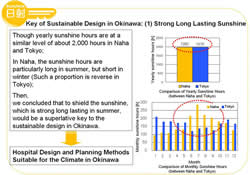Okinawa Prefectural Nanbu Medical Center & Children's Medical Center
Multi-functional vertical louvers
 |
|||
| Key element of sustainable design 1: strong and prolonged sunlight | |||
 |
 |
 |
|
While annual hours of daylight in Naha and Tokyo are both approximately 2,000 hours, in Naha, however, daylight hours are long in summer and short in winter (opposite Tokyo's daylight pattern), making the blocking of particularly intense, extended summer daylight a key element of sustainable design for this region.
To this end, the hospital was furnished with light-weight GRC vertical louvers with no wood frame to block Okinawa's strong sunlight, while its deep-set facade design protects the building openings from strong wind gusts and flying objects from typhoons. In addition, some louvers are set diagonally outward in order to provide patient privacy by blocking the view from opposing windows. Use of multi-functional vertical louvers (i.e., sun shielding, environmental performance, wind gust protection and privacy protection) provides the hospital with long-lasting sustainability well-adapted to the regional climate.
Task/ambient A/C system for 4-bed inpatient room (cool air radiated from ceiling)
 |
|||
| Key element of sustainable design 2: high outside temperature | |||
 |
 |
 |
 |
 |
|||
Air conditioning is required almost year-around in Okinawa with the exception of 1 to 2 weeks typically between mid-January and early February when heating is required. Outside air temperature remains high with little day and night fluctuation, particularly in summer. Thus, minimizing temperature differences in and outside of inpatient rooms is an important energy-saving feature for sustainable design.
4-bed inpatient rooms are equipped with task/ambient A/C system. While ambient indoor air set at approximately 28°C provides a small temperature difference from outside, the system allows individuals to adjust their personal environment by controlling air flow according to their preferences and needs. Figure 4 shows the system flow diagram. Furthermore, as shown in Figure 5, the system achieves improved patient comfort and energy efficiency in individual spaces by using the Coandă effect, in which cooling air is supplied along the ceiling surface, allowing cooling air to radiate from the ceiling and eliminating cold drafts.
Desiccant A/C system and water-conveyance cold-source system using mid-large temperature difference
 |
|||
| Key element of sustainable design 3: high dehumidification loads | |||
 |
 |
 |
 |
The energy required for air cooling/dehumidifying process in Okinawa is 2.5 times that of Tokyo due to its climate. In a hospital setting, where high fresh air intake occurs and humidity control is crucial, reduction in energy use for the dehumidification process is a key element in sustainable design.
The desiccant A/C system for this hospital uses absorbent material for dehumidification, thus achieving a 38% reduction in cold energy under outdoor air design conditions. Furthermore, a water-conveyance system using mid-large temperature difference (10-20°C) was selected based on the characteristics of the desiccant A/C system that allow dehumidification by sensible heat cooling at approximately 23°C. This heat source system resulted in both an improvement in refrigerator COP (up 3.8%) and a reduction in water conveyance motive energy (down 43%), achieving a total reduction of approximately 41% in power consumption when combined with the desiccant A/C system.
A performance study of desiccant A/C systems based on climate data for 10 domestic sites and 7 overseas sites shows the reduction in annual primary energy consumption per outdoor air intake decreases in proportion to the latitude, indicating higher performance in high-humidity areas at low latitudes.
Previous Building |
 |
 |
 |
 |
 |
 Next Building Next Building |
CASBEE is a method for rating the environmental performance of buildings using Building Environmental Efficiency (BEE) as an indicator, which is based on the results of separate scores obtained for Q-1~Q-3 (Quality) and LR-1~LR-3 (Load Reduction).















 | Copyright © 2008 Institute for Building Environment and Energy Conservation, All Rights Reserved.
| Copyright © 2008 Institute for Building Environment and Energy Conservation, All Rights Reserved.